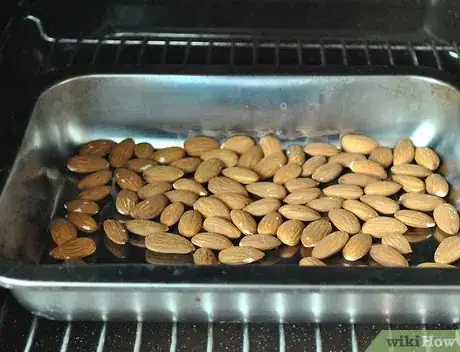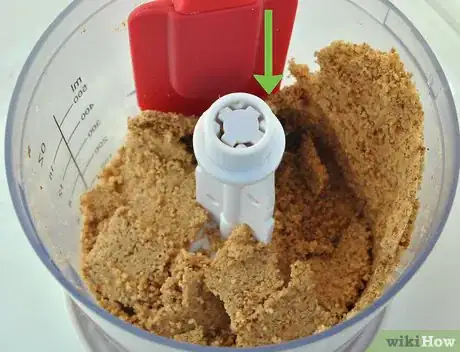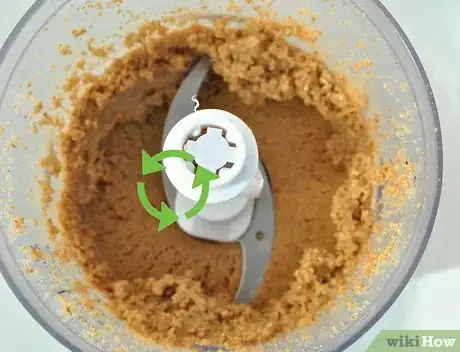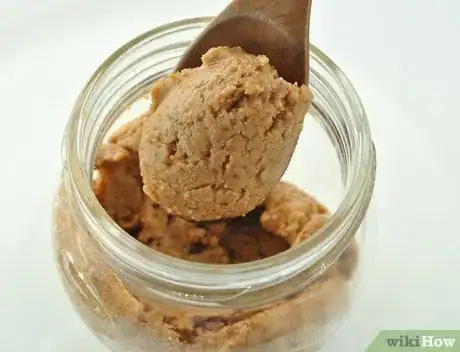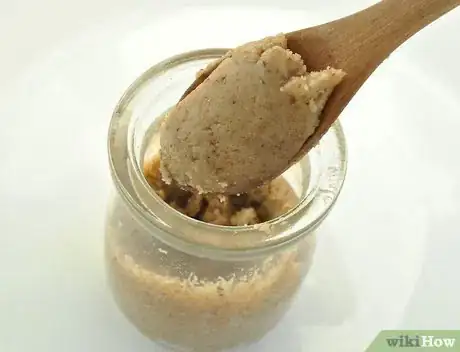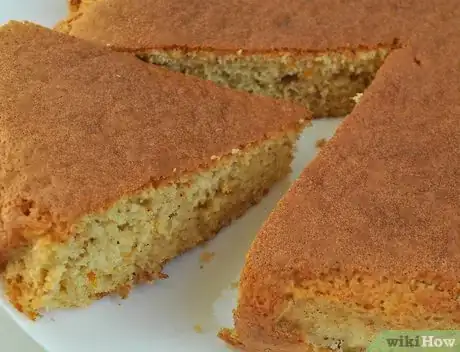This article was co-authored by Marrow Private Chefs. Marrow Private Chefs are based in Santa Rosa Beach, Florida. It is a chefs’ collaborative comprised of an ever-growing number of chefs and culinary professionals. Though regionally influenced primarily by coastal, traditional southern, cajun, and creole styles and flavors, the chefs at Marrow have a solid background in all types of cuisine with over 75 years of combined cooking experience.
There are 7 references cited in this article, which can be found at the bottom of the page.
wikiHow marks an article as reader-approved once it receives enough positive feedback. In this case, several readers have written to tell us that this article was helpful to them, earning it our reader-approved status.
This article has been viewed 81,669 times.
Although it takes a little patience, making your own almond butter is a very simple process. The same technique can also be applied to other varieties of nuts for even faster results. Enjoy your almond butter on its own or include it in any recipes that call for nut butter or paste!
Ingredients
- 2 cups raw unsalted almonds
- 1-2 teaspoons coarse sea salt (or to taste)
- 1-3 teaspoons of olive oil (if needed)
Steps
Making Your Butter
-
1Roast the almonds. Preheat your oven to 250 degrees Fahrenheit (121 degrees Celsius). Arrange your nuts on a baking sheet. Cook them for 10 to 15 minutes.[1]
- Roasting temperature and time may vary by oven. For your first time, start with the lower temperature of 250 degrees F (121 degrees C) to avoid burning the nuts. Once you have a better sense of cooking time, use a higher temperature (350 degrees F or 177 degrees C) for a quicker roasting time (about 8 to 10 minutes.[2]
- Pay attention to their coloring as they cook. Remove when they have toasted to a slight brown, before they can burn.[3]
- This step is not strictly necessary, but heating the nuts’ natural oils will make blending them easier.
-
2Transfer them to a food processor. Alternately, use a food blender if that is all you have, but a food processor will blend the nuts more thoroughly without needing as much added oil.[4] Slowly pour the almonds in while running the processor on pulse. Allow the processor to start chopping the nuts a little at a time rather than dumping the whole load in at once.[5]
- Set aside some nuts to add later if you prefer a chunky butter.[6]
Advertisement -
3Continue processing. Run the processor for approximately 10 minutes, at which point the nuts’ released oils should begin to smooth the mixture. Turn the machine off as the blended nuts start to build up along the container’s sides. Remove the lid and use a spatula to push the mixture back down toward the blades. Replace the lid and resume blending until you need to push the mixture back down again. Repeat as needed.[7]
- The amount of time may vary according to the strength of your food processor and the amount of nuts.
-
4Blend until the butter is smooth. After approximately 20 minutes of constant blending, expect the mixture to attain a creamier consistency.[8] If clumpiness persists, add a teaspoon of olive oil to soften the mixture. Continue blending and adding oil until it reaches your desired consistency.[9]
- Add salt as desired and continue blending to mix it in.
- Add extra roasted almonds and process briefly for chunky butter.
-
5Store the butter. Unplug the machine and detach the canister from the base. Use a serving spoon to transfer the bulk of the butter from the processor to an airtight container. Remove the S-blade and use your spoon or spatula to push any clinging butter into the container. Then rake up any butter clinging to the processor’s sides. Seal your container when finished and store it in the refrigerator.[10]
- Refrigerated almond butter should last up to 3 weeks.[11]
Using Alternative Ingredients
-
1Add honey-roasted peanuts. Give your almond butter some extra flavor. Purchase some pre-roasted peanuts. Add ⅓ cup of these to every 2 cups of almonds during the blending process.[12]
-
2Substitute cashews for almonds. For quicker roasting and blending, use this softer nut instead. Save money by purchasing them in raw chunks from the bulk section, since whole pieces may be more expensive than almonds. They also tend to be drier, so be sure to have oil on hand to blend them to your desired consistency.[13]
- When roasting, start checking their coloring no later than 7 minutes into cooking. Cashews will begin to burn sooner than almonds would.
-
3Use pecans for minimal effort. Replace almonds with pecans for to create a butter in less time with less fuss. Skip the roasting process altogether, even with raw pecans. Simply blend until the mixture is even.[14]
Serving and Baking
-
1Enjoy almond butter straight from the fridge. Make a plain almond butter sandwich, or add jam like a traditional PB-&-J. Scoop almond butter up with apple slices. Smear it over crackers, biscuits, toast, or pancakes.[15]
-
2Add almond butter to smoothies. Give your smoothie extra protein and a nutty taste. Experiment by adding some to your favorite recipe. Or, try blending 1 tablespoon with the following ingredients:[16]
- 2 cups fresh spinach
- 1 cup almond milk (vanilla, original, or unsweetened, according to your taste)
- Half of a ripe banana
- ¼ cup pineapple chunks
-
3Bake cookies with almond butter. First, preheat the oven to 400 degrees Fahrenheit (204 degrees Celsius). While the oven heats, create your cookie dough:[17]
- Combine the following in a mixing bowl: ½ cup dairy butter, ½ cup shortening, 6 ounces almond butter, and 1 ⅓ cup sugar.
- Break one egg and beat the contents into the mixture.
- In a separate bowl, mix 2 cups of all-purpose flour with 1 teaspoon of baking soda.
- Slowly pour the flour/soda mixture into the first bowl, stirring as you go.
- Roll the dough into balls roughly a quarter of an inch in size and then arrange these on an ungreased baking sheet, with at least two inches between each ball.
- Bake for 8 to 10 minutes and then transfer them to a cooling rack.
-
4Make an almond butter cake. Preheat your oven to 350 degrees Fahrenheit (177 degrees Celsius). Then use greased parchment paper to line an 8” x 8” baking pan. Then create your batter:[18]
- First, mix the following in a bowl: 5 tablespoons almond flour, 5 tablespoons buckwheat flour, 2 tablespoons arrowroot flour, ½ teaspoon baking soda, ½ teaspoon baking powder, ½ teaspoon kosher salt, and ¼ teaspoon ground nutmeg.
- In another, larger bowl, combine these ingredients: ½ cup melted coconut oil, ¾ cup almond butter, ¾ honey, and 1 teaspoon vanilla extract.
- Next, beat one egg into the wet ingredients.
- Slowly pour the dry ingredients into the wet batter, stirring as you go.
- Pour the finished batter into the pan and bake for 30 to 40 minutes.
Community Q&A
-
QuestionDoes almond butter need to be refrigerated?
 Emilia MeyerCommunity AnswerIt´s not necessary, it´s more of a taste thing. If you like it smoother and runny, keep it at room temperature.
Emilia MeyerCommunity AnswerIt´s not necessary, it´s more of a taste thing. If you like it smoother and runny, keep it at room temperature.
Things You Will Need
- Almonds
- Baking sheet
- Oven
- Food processor
- Spatula
- Coarse salt
- Spatula
- Serving spoon
References
- ↑ http://www.mahalo.com/how-to-make-almond-butter
- ↑ http://www.mahalo.com/how-to-make-almond-butter
- ↑ http://www.backwoodshome.com/make-your-own-nut-butters/
- ↑ http://www.backwoodshome.com/make-your-own-nut-butters/
- ↑ http://www.mahalo.com/how-to-make-almond-butter
- ↑ http://www.backwoodshome.com/make-your-own-nut-butters/
- ↑ http://www.mahalo.com/how-to-make-almond-butter
- ↑ http://www.mahalo.com/how-to-make-almond-butter
- ↑ http://www.backwoodshome.com/make-your-own-nut-butters/
- ↑ http://www.mahalo.com/how-to-make-almond-butter
- ↑ http://sallysbakingaddiction.com/homemade-almond-butter/
- ↑ http://sallysbakingaddiction.com/homemade-almond-butter/
- ↑ http://www.backwoodshome.com/make-your-own-nut-butters/
- ↑ http://www.backwoodshome.com/make-your-own-nut-butters/
- ↑ http://www.mahalo.com/how-to-make-almond-butter
- ↑ http://whatsgabycooking.com/almond-butter-spinach-smoothie/#.U4Sw85SG02K
- ↑ http://allrecipes.com/recipe/122003/almond-butter-cookies/
- ↑ https://food52.com/recipes/23807-almond-butter-honey-cake
- Videos provided by Everyday Food
About This Article
To make almond butter, start by roasting some almonds in the oven for 15 minutes at 250 degrees Fahrenheit. Then, transfer the roasted almonds to a food processor and blend them for 10 minutes. After 10 minutes, use a spatula to scrape the almond mixture off the sides of the food processor and back down toward the blades. Finally, blend the mixture for another 10 minutes or until it has a smooth, creamy texture. To learn how to bake using your almond butter, scroll down!
